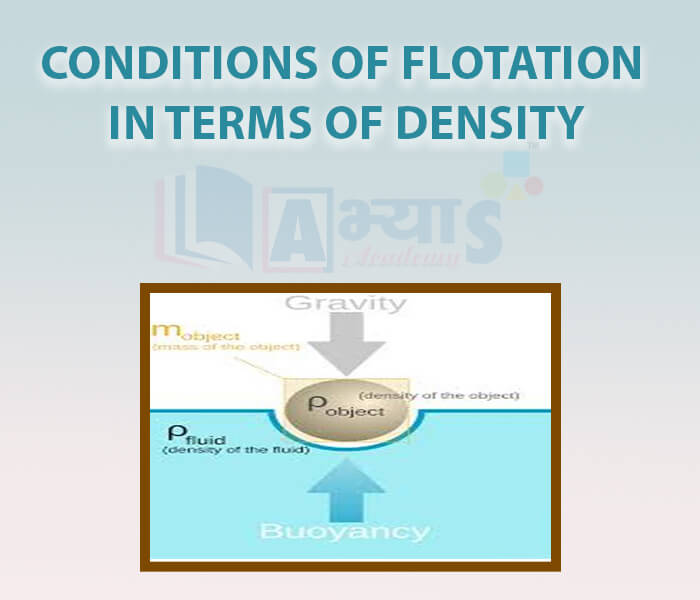Conditions for Flotation in terms of density










Conditions for Flotation in terms of density
CONDITIONS FOR FLOATATION IN TERM OF DENSITY: Factors Affecting Buoyant Force or Floatation :
The magnitude of buoyant force or floatation depends on the following factors:
(i) Density of the Fluid: The liquid having higher density exerts more upward buoyant force on an object than another liquid of lower density. This is the reason, why it is easier to swim in sea water in comparison to normal water. Because sea water has higher density and hence exerts a greater buoyant force on the swimmer than the fresh water having lower density.
(ii) Volume of Object Immersed in the Liquid: As the volume of solid object immersed inside the liquid increases, the upward buoyant force also increases.
The magnitude of buoyant force acting on a solid object does not depend on the nature of the solid object. It depends only on its volume. e.g. When two balls made of different metals having different weights but equal volume when fully immersed in a liquid, they will experience an equal upward buoyant force as both the balls displace equal weight of the liquid due to their equal volumes.
For bodies with no air space: An ice cube, wooden block, a rod, a nail, etc., are bodies that have no vacant space or air space,i.e. there is no air trapped in them. The condition for the floatation of such bodies and the liquid concerned.
Suppose the volume of abody is V and its density is . Suppose it is immerged in a liquid of density
.
The mass of the body is M =
The weight of the body is W = Mg = Vg
The volume of the displaced liquid = V
The weight of this displaced liquid = Vg
Thus, the force of buoyancy B = Vg
The body will come up and float if
B > W
Vg = V
g
Thus, a body that has no air space will float only if its density is less than that of the liquid.
For bodies with air space: A small needle made of stainless steel sinks in water, but a larger bowl made up of stainless steel floats. This is beacause a bowl can displace a much greater volume of water than the volume of steel used to make it. A covered bowl which can hold one litre of milk, can displace slightly more than 1 litre of water when completely immerged in the water.So we should be more careful while using the equation.
As the volume of solid object immersed inside the liquid _________________, the upward buoyant force also increases. | |||
| Right Option : A | |||
| View Explanation | |||
As the volume of solid object immersed inside the liquid increases, the upward buoyant force also __________________. | |||
| Right Option : A | |||
| View Explanation | |||
The liquid having _______________ density exerts more upward buoyant force on an object than another liquid of lower density. | |||
| Right Option : B | |||
| View Explanation | |||
Students / Parents Reviews [10]
It was good as the experience because as we had come here we had been improved in a such envirnment created here.Extra is taught which is beneficial for future.

Eshan Arora
8thOne of the best institutes to develope a child interest in studies.Provides SST and English knowledge also unlike other institutes. Teachers are co operative and friendly online tests andPPT develope practical knowledge also.

Aman Kumar Shrivastava
10thIt was a good experience with Abhyas Academy. I even faced problems in starting but slowly and steadily overcomed. Especially reasoning classes helped me a lot.

Cheshta
10thMy experience with Abhyas academy is very good. I did not think that my every subject coming here will be so strong. The main thing is that the online tests had made me learn here more things.

Hiya Gupta
8thMy experience was very good with Abhyas academy. I am studying here from 6th class and I am satisfied by its results in my life. I improved a lot here ahead of school syllabus.

Ayan Ghosh
8thAbhyas is a complete education Institute. Here extreme care is taken by teacher with the help of regular exam. Extra classes also conducted by the institute, if the student is weak.

Om Umang
10thBeing a parent, I saw my daughter improvement in her studies by seeing a good result in all day to day compititive exam TMO, NSO, IEO etc and as well as studies. I have got a fruitful result from my daughter.

Prisha Gupta
8thAbhyas Methodology is very good. It is based on according to student and each child manages accordingly to its properly. Methodology has improved the abilities of students to shine them in future.

Manish Kumar
10thIt has a great methodology. Students here can get analysis to their test quickly.We can learn easily through PPTs and the testing methods are good. We know that where we have to practice

Barkha Arora
10thI have spent a wonderful time in Abhyas academy. It has made my reasoning more apt, English more stronger and Maths an interesting subject for me. It has given me a habbit of self studying
